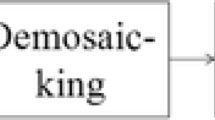Abstract
In this paper, we introduce an intra-field deinterlacing algorithm based on a wavelet-content-adaptive back propagation (BP) neural network (BP-NN) using pixel classification. During interpolation, there is an issue of different image features having completely different properties, such as smooth regions, edges, and textures. We use the wavelet transform to divide the images into several pieces with different properties. Then, each piece has similar image features and each one is assigned to one neural network. The BP-NN-based deinterlacing algorithm can reduce blurring by recovering the missing pixels via a learning process. Compared with existing deinterlacing algorithms, the proposed algorithm improves the peak signal-to-noise ratio and visual quality while maintaining high efficiency.







Similar content being viewed by others
References
Aggarwal U, Trocan M, Coudoux F-X (2017) An HVS-inspired video deinterlacer based on visual saliency. Vietnam J Comput Sci 4(1):6169
Bellars EB, De Haan G (2000) Deinterlacing: a key technology for scan rate conversion. Elsevier, Amsterdam
Canny J (1986) A computational approach to edge detection. IEEE Trans Pattern Anal Mach Intell 8:679–698
Chen P-Y, Lai Y-H (2007) A low-complexity interpolation method for deinterlacing. IEICE Trans Inf Syst E90–D(2):606608
Chen T, Wu HR, Yu ZH (2000) Efficient deinterlacing algorithm using edge-based line average interpolation. Opt Eng 39(8):21012105
De Haan G (2007) Television display processing: past and future. In: Proceedings of IEEE ICCE07, Las Vegas, pp 12
Ding S, Su C, Yu J (2011) An optimizing BP neural network algorithm based on genetic algorithm. J Artif Intell Rev 36(2):153162
Doyle T (1998) Interlaced to sequential conversion for EDTV applications. In: Proceedings of 2nd international workshop signal processing of HDTV, pp 412–430
Jack K (2005) Video demystified: a handbook for the digital engineer, 4th edn. Elsevier, Jordan Hill, Oxford
Jeon G, Anisetti M, Kang SH (2013) A rank-ordered marginal filter for deinterlacing. Sensors (Basel) 13(3):3056305
Kang K, Jeon G, Jeong J (2009) A single field interlaced to progressive format conversion using edge map in the image block. In: Proceedings of IASTED SIP 2009, pp 8085, Hawaii, USA, 606608
Kim Y (1996) Deinterlacing algorithm based on sparse wide vector correlations. SPIE Opt Eng 2727:8999
Kim W, Jin S, Jeong J (2007) Novel intra deinterlacing algorithm using content adaptive interpolation. IEEE Trans Consum Electron 53(3):10361043
Lee D-H (2008) A new edge-based intra-field interpolation method for deinterlacing using locally adaptive-thresholded binary image. IEEE Trans Consun Electron 54(1):110115
Mallat S, Zhong S (1992) Characterization of signals from multiscale edges. IEEE Trans Pattern Anal Mach Intell 14:710–732
Michaud F, Le Dinh CT, Lachiver G (1997) Fuzzy detection of edgedirection for video line doubling. IEEE Trans Circuits Syst Video Technol 7(3):539542
Park MK, Kang MG, Nam K, Oh SG (2003) New edge dependent deinterlacing algorithm based on horizontal edge pattern. IEEE Trans Consun Electron 49(4):15081512
Qiang J, Chen J, Wang J (2014) An interfield and intrafield weighted interpolative deinterlacing algorithm based on low-angle detection and multiangle extraction. Math Probl Eng, Article ID 972540
Seo G, Choi H, Lee C (2009) Efficient implementation of neural network deinterlacing. Proc SPIE 7245:724519
Souza C (2009) Neural network learning by the Levenberg–Marquardt algorithm with Bayesian regularization. https://www.codeproject.com/articles/55691/neural-networklearning-by-the-levenberg-marquardt
Wang D, Vincent A, Blanchfield P (2005) Hybrid de-interlacing algorithm based on motion vector. IEEE Trans Circuits Syst Video Technol 15(8):10191025
Yang S, Kim D, Jeong J (2009) Fine edge-preserving deinterlacingalgorithm for progressive display. IEEE Trans Consum Electron 5(3):1654–1662
Yoo H, Jeong J (2002) Direction-oriented interpolation and its application to deinterlacing. IEEE Trans Consum Electron 48(4):954962
Acknowledgements
This research was supported by Basic Science Research Program through the National Research Foundation of Korea (NRF) funded by the Ministry of Science, ICT and future Planning (NRF-2015R1A2A2A01006004).
Author information
Authors and Affiliations
Corresponding author
Ethics declarations
Conflict of interest
We declare that we have no financial and personal relationships with other people or organizations that can inappropriately influence our work, there is no professional or other personal interest of any nature or kind in any product, service and/or company that could be construed as influencing the position presented in, or the review of, the manuscript entitled, “Wavelet-content-adaptive BP neural network-based deinterlacing algorithm”.
Additional information
Communicated by M. Anisetti.
Rights and permissions
About this article
Cite this article
Wang, J., Jeong, J. Wavelet-content-adaptive BP neural network-based deinterlacing algorithm. Soft Comput 22, 1595–1601 (2018). https://doi.org/10.1007/s00500-017-2968-x
Published:
Issue Date:
DOI: https://doi.org/10.1007/s00500-017-2968-x




